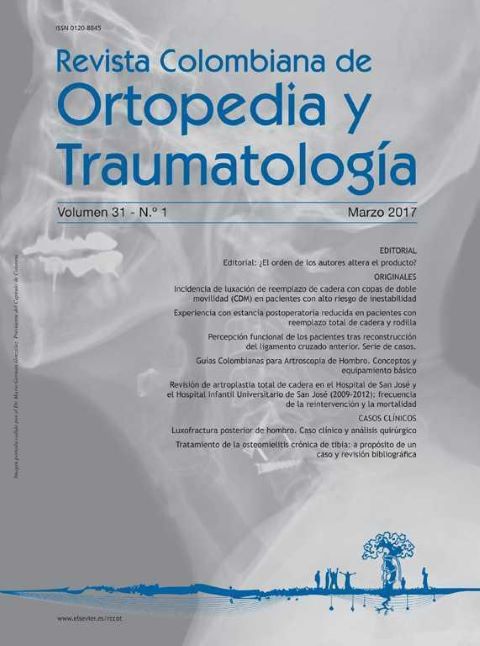Re-interventions and mortality in revision total hip replacement in the Hospitals San José and Infantil Universitario de San José, 2009-2012
DOI:
https://doi.org/10.1016/j.rccot.2017.01.001Keywords:
hip replacement surgery, re-operation, mortality, case studiesAbstract
Background: Revision total hip replacement surgery is more serious than the primary intervention, and prognosis is directly affected by the findings, surgical complications, re-operations, and patient sociodemographic characteristics.
Materials and methods: A descriptive study was conducted on a case series of patients between 30 and 95 years-old who underwent total hip replacement revision in San José Hospital and the San José University Children’s Hospital between January 2009 and July 2012. Their demographic and clinical data were stored in a database and analysed using descriptive statistics.
Results: The study included 70 patients with mean age 63 ± 14 years, with 38 (54%) women. The causes of primary revision were: aseptic loosening (44%), septic loosening (33%), prosthetic dislocation (17%), and peri-prosthetic fracture (6%). The mean surgical time was 142 ± 68 minutes for the first revision and 133 ± 19 minutes for the second revision. The maximum number of revisions was 2, but the number of re-operations for other reasons was higher. The main causes of re-operation were: superficial surgical site infection (63.15%), prosthetic dislocation (15.7%), peri-prosthetic fracture (11%), and deep surgical site infection (5.2%). Early mortality during the initial revision was 0%, while for the second re-operation and revision time, it was 5% and 11%, respectively.
Discussion: The causes of primary revision and re-intervention found in this study are consistent with those reported in the literature. The subsequent re-operations are common and are associated mostly to peri-prosthetic fractures and infections. Fractures were the main intra-operative complication and mortality was associated with infection.
Evidence level: IV.
Downloads
References
Retpen JB, Varmarken JE, Rock ND, Jensen JS. Unsatisfactory results after repeated revision of hip arthroplasty. 61 cases followed for 5 (1-10) years. Acta Orthop Scand. 1992;63:120-7. https://doi.org/10.3109/17453679209154807
Springer BD, Fehring TK, Griffin WL, Odum SM, Masonis JL. Why revision total hip arthroplasty fails. Clin Orthop Relat Res. 2009;467:166-73. https://doi.org/10.1007/s11999-008-0566-z
Labek G, Thaler M, Janda W, Agreiter M, Stockl B. Revision rates after total joint replacement: cumulative results from worldwide joint register datasets. J Bone Joint Surg Br. 2011;93:293-7. https://doi.org/10.1302/0301-620X.93B3.25467
Skutek M, Bourne RB, MacDonald SJ. International epidemiology of revision THR. Curr Orthop. 2006;20:157-61. https://doi.org/10.1016/j.cuor.2006.06.012
Barrack RL. Economics of revision total hip arthroplasty. Clin Orthop Relat Res. 1995;319:209-14. https://doi.org/10.1097/00003086-199510000-00022
Huo MH. Disparity in revision total hip replacement: clinical outcome, cost, and surgeon work force. Curr Orthop Pract. 2010;21:4. https://doi.org/10.1097/BCO.0b013e3181ce0ac3
Sams JD, Francis ML, Scaife SL, Robinson BS, Novicoff WM, Saleh KJ. Redefining revision total hip arthroplasty based on hospital admission status. J Arthroplasty. 2012;27:758-63. https://doi.org/10.1016/j.arth.2011.09.007
Prokopetz JJ, Losina E, Bliss RL, Wright J, Baron JA, Katz JN. Risk factors for revision of primary total hip arthroplasty: a systematic review. BMC Musculoskelet Disord. 2012; 13:251. https://doi.org/10.1186/1471-2474-13-251
Ulrich SD, Seyler TM, Bennett D, Delanois RE, Saleh KJ, Thongtrangan I, et al. Total hip arthroplasties: what are the reasons for revision? Int Orthop. 2008;32:597-604. https://doi.org/10.1007/s00264-007-0364-3
Kim Y, Morshed S, Joseph T, Bozic K, Ries MD. Clinical impact of obesity on stability following revision total hip arthroplasty. Clin Orthop Relat Res. 2006;453:142-6. https://doi.org/10.1097/01.blo.0000238874.09390.a1
Bozic KJ, Kurtz SM, Lau E, Ong K, Vail TP, Berry DJ. The epidemiology of revision total hip arthroplasty in the United States. J Bone Joint Surg Am. 2009;91:128-33. https://doi.org/10.2106/JBJS.H.00155
Dale H, Hallan G, Espehaug B, Havelin LI, Engesaeter LB. Increasing risk of revision due to deep infection after hip arthroplasty. Acta Orthop. 2009;80:639-45. https://doi.org/10.3109/17453670903506658
Bottner MF, Sculco TP. Infection in revision total hip arthroplasty. Tech Orthop. 2001;16:12. https://doi.org/10.1097/00013611-200109000-00010
Kalra KP, Lin KK, Bozic KJ, Ries MD. Repeat 2-stage revision for recurrent infection of total hip arthroplasty. J Arthroplasty. 2010;25:880-4. https://doi.org/10.1016/j.arth.2009.12.010
Leonard HA, Liddle AD, Burke O, Murray DW, Pandit H. Singleor two-stage revision for infected total hip arthroplasty? A systematic review of the literature. Clin Orthop Relat Res. 2014;472:1036-42. https://doi.org/10.1007/s11999-013-3294-y
Pulido L, Rachala SR, Cabanela ME. Cementless acetabular revision: past, present, and future. Revision total hip arthroplasty: the acetabular side using cementless implants. Int Orthop. 2011;35:289-98. https://doi.org/10.1007/s00264-010-1198-y
Sporera SM, Paprosky WG. Cementless femoral revision: The role of monoblock versus modular stems. Curr Orthop. 2006;20:171-8. https://doi.org/10.1016/j.cuor.2006.02.006
Lübbeke ARC, Barea C, Köhnlein W, Hoffmeyer P. Revision total hip arthroplasty in patients 80 years or older. J Arthroplasty. 2012:1041-6. https://doi.org/10.1016/j.arth.2011.11.023
Radcliffe GS, Tomichan MC, Andrews M, Stone MH. Revision hip surgery in the elderly: is it worthwhile? J Arthroplasty. 1999;14:38-44. https://doi.org/10.1016/S0883-5403(99)90200-0
Downloads
Published
How to Cite
Issue
Section
License
Copyright (c) 2024 Revista Colombiana de ortopedia y traumatología

This work is licensed under a Creative Commons Attribution 3.0 Unported License.

| Article metrics | |
|---|---|
| Abstract views | |
| Galley vies | |
| PDF Views | |
| HTML views | |
| Other views | |




